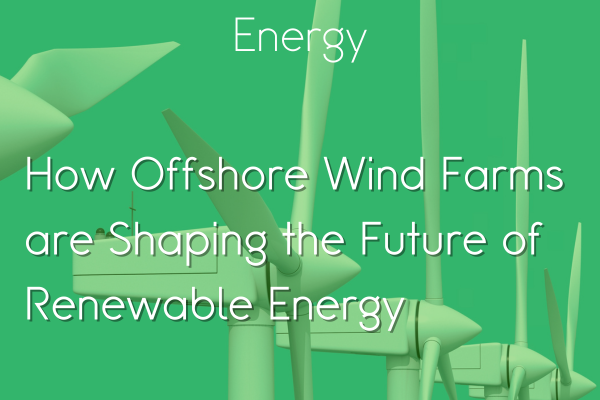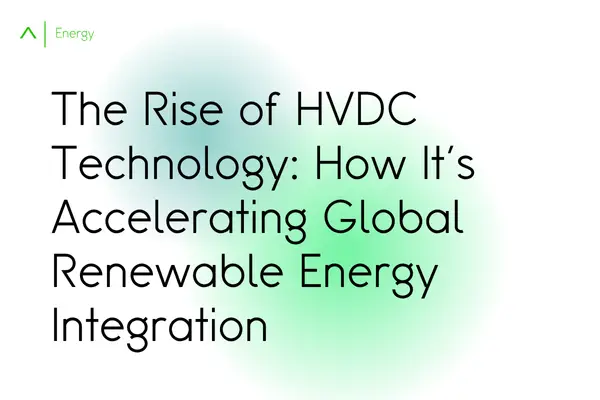How Offshore Wind Farms are Shaping the Future of Renewable Energy
17 Oct, 20245 minsIn the vast expanse of our oceans, a revolution is taking place. Towering turbines, their bl...

In the vast expanse of our oceans, a revolution is taking place. Towering turbines, their blades spinning in the relentless sea winds, are not just generating clean electricity—they're reshaping our entire approach to renewable energy. Offshore wind farms, once a novel concept, are rapidly becoming a cornerstone of the global transition to sustainable power. Let's dive into how these maritime marvels are charting a course for a greener future.
The Rise of Offshore Wind
Offshore wind farms have come a long way since the first installation off the coast of Denmark in 1991. Today, they stand as behemoths of engineering, with some turbines reaching heights of over 250 metres—taller than the London Eye! The United Kingdom, in particular, has embraced this technology with gusto, positioning itself as a world leader in offshore wind energy.
As of 2023, the UK boasts the largest installed offshore wind capacity in the world, with over 10 GW of operational capacity. Projects like Hornsea One, located 120 km off the Yorkshire coast, showcase the scale of these developments. With 174 turbines spread across 407 square kilometres, Hornsea One alone can power over one million UK homes.
Why Go Offshore?
The advantages of locating wind farms at sea are numerous:
1. Stronger, more consistent winds: Offshore winds are typically stronger and more reliable than those on land, leading to higher energy production. For instance, offshore wind farms in the UK typically achieve capacity factors of 40-50%, compared to 25-30% for onshore wind.
2. Less visual impact: Placed far from shore, these farms have minimal impact on coastal landscapes. Modern farms can be situated up to 80 km from the coast, virtually invisible from land.
3. Larger turbines: The open ocean allows for the installation of massive turbines that would be impractical on land. The GE Haliade-X, for example, boasts a 220-metre rotor diameter and can generate up to 14 MW—enough to power around 16,000 European households.
4. No land use conflicts: Offshore farms don't compete with agriculture or urban development for space, a significant advantage in densely populated countries like the UK.
Technological Innovations Driving Growth
The offshore wind sector is a hotbed of innovation, with new technologies constantly pushing the boundaries of what's possible:
Floating Turbines
One of the most exciting developments is the advent of floating wind turbines. These marvels of engineering can be anchored in deep waters, opening up vast new areas for wind energy production. Projects like the Hywind Scotland farm are proving that floating turbines are not just feasible but highly effective.
Hywind Scotland, the world's first commercial floating wind farm, consists of five 6 MW turbines located 25 km off the coast of Peterhead, Aberdeenshire. Despite being in waters up to 129 metres deep, the farm has achieved capacity factors of up to 57%—significantly higher than typical fixed-bottom offshore wind farms.
The floating foundations used in these projects come in several designs:
1. Spar-buoy: A long, slender cylinder that extends deep below the surface, providing stability through ballast.
2. Semi-submersible: A platform with several columns connected by submerged pontoons.
3. Tension-leg platform: A floating structure tethered to the seabed by tensioned mooring lines.
Each design has its advantages, and research is ongoing to determine the most cost-effective and reliable solutions for different sea conditions.
Larger, More Efficient Turbines
The trend towards bigger turbines continues unabated. The latest designs boast rotor diameters of over 220 metres, capable of powering thousands of homes with a single revolution. These giants are not just larger; they're smarter too, with advanced materials and designs that increase efficiency and reduce maintenance needs.
Key innovations include:
• Carbon fibre blades: Lighter and stronger than traditional fibreglass, allowing for longer blades without excessive weight.
• Direct drive generators: Eliminating the need for a gearbox, reducing maintenance requirements and improving reliability.
• Digital twins: Virtual replicas of turbines that use real-time data to optimise performance and predict maintenance needs.
Advanced Grid Integration
Integrating large amounts of variable wind power into the grid presents challenges, but innovative solutions are emerging. High-voltage direct current (HVDC) transmission systems are being developed to efficiently transport power from distant offshore farms to onshore grids.
HVDC systems offer several advantages for offshore wind:
• Lower transmission losses: HVDC cables can transmit power over long distances with fewer losses than traditional AC systems.
• Improved grid stability: HVDC links can help balance power flows and improve overall grid stability.
• Interconnection potential: HVDC systems can facilitate the creation of international power grids, like the proposed North Sea Wind Power Hub.
Additionally, energy storage technologies, including batteries and hydrogen production, are being explored to balance supply and demand. The Batwind project, associated with Hywind Scotland, uses a 1 MW battery system to optimise power output and mitigate intermittency.
Environmental Considerations
While offshore wind farms offer clear benefits in terms of clean energy production, their environmental impact is carefully considered:
• Marine life: Studies are ongoing to understand and mitigate the effects on marine ecosystems. Some evidence suggests that wind farm foundations can act as artificial reefs, potentially benefiting marine biodiversity. For example, research at the Kentish Flats wind farm in the UK has shown increased abundance of some fish species around turbine foundations.
• Bird populations: Measures are being taken to minimise the risk to bird populations, including careful siting of farms and the use of technologies to detect and avoid collisions. The Offshore Renewables Joint Industry Programme (ORJIP) in the UK is leading research into bird behaviour around offshore wind farms, using advanced radar and camera systems.
• Noise reduction: Innovations in foundation design and installation techniques are helping to reduce underwater noise during construction. "Big Bubble Curtains," which create a wall of air bubbles around pile-driving operations, can reduce noise levels by up to 20 decibels.
Economic Impact
The growth of offshore wind is not just an environmental story—it's an economic one too. The sector is creating thousands of jobs in manufacturing, construction, and maintenance. Coastal communities, particularly in areas affected by the decline of traditional industries, are seeing new opportunities emerge.
In the UK, the government's commitment to 50 GW of offshore wind capacity by 2030 is driving significant investment. This ambitious target is expected to create up to 60,000 jobs and attract billions in private sector investment.
Specific economic benefits include:
• Supply chain development: The UK is developing a robust supply chain for offshore wind, with companies like Siemens Gamesa establishing major manufacturing facilities in Hull.
• Port regeneration: Ports like Grimsby and Lowestoft are being revitalised as hubs for offshore wind operations and maintenance.
• Export opportunities: UK expertise in offshore wind is creating export opportunities, with companies providing services and technology to projects worldwide.
The Road Ahead
As impressive as current offshore wind technology is, the future holds even more promise:
• Synergies with other technologies: Concepts like combining offshore wind with hydrogen production or wave energy are being explored. The Oyster project, led by ITM Power, Ørsted, and Siemens Gamesa, aims to demonstrate the feasibility of combining offshore wind power with hydrogen production.
• Artificial intelligence: AI and machine learning are being leveraged to optimise turbine performance and predict maintenance needs. For example, GE's Digital Wind Farm uses AI to adjust turbine operations in real-time based on weather conditions and grid demands.
• Multi-use offshore platforms: There's growing interest in creating platforms that combine wind energy with other uses, such as aquaculture or solar power. The EU-funded MERMAID project has explored various multi-use designs, including combinations of wind farms with wave energy, aquaculture, and shipping route management.
Offshore wind farms are more than just a source of clean energy—they're a testament to human ingenuity and our commitment to a sustainable future. As technology advances and costs continue to fall, these maritime power plants will play an increasingly crucial role in our energy mix.
The UK, with its vast coastline and favourable wind conditions, is well-positioned to lead this revolution. As we look to the horizon, we see not just spinning turbines, but a future where clean, renewable energy powers our homes, businesses, and dreams of a greener world.
In the face of climate change, offshore wind farms offer hope—a powerful reminder that with innovation and determination, we can harness the forces of nature to protect our planet for generations to come. The journey of offshore wind is just beginning, and the possibilities are as vast as the oceans themselves.



